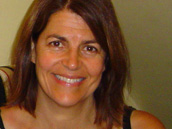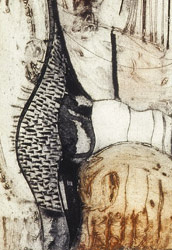Pushalot, Lithuania
Dawn Promislow
I was in Lithuania. I thought I would try to see the village of Pusalotas. My friend’s father came from there; it was a shtetl with two hundred Jewish inhabitants on the eve of the Second World War. The town was known, in Yiddish, as Pushalot.
So I hired a man to drive me, one day, the hundred and fifty kilometres from Vilnius to Pushalot. I would call it Pushalot. The man I hired charged far more than was reasonable and spoke almost no English. But he had a new black Mercedes, and he drove very fast. This was good.
Leaving the main highway at the city of Panevezys, we found ourselves on a narrow road that went straight across a flat landscape. We slowed. I saw a rusty tractor, a windmill once, and some storks. A pedestrian and bicycle path ran parallel to the road, and a bicycle glinted in the sun, as a man pedaled alongside us for a while. We arrived, after thirty minutes, at a sign saying “Pusalotas.”
And so here was Pushalot. There were small wooden houses. The houses, worn timber, might be what could be described as sheds. But they were houses. They sat mostly on the road, their doorways opening directly onto the street. Some houses had their doorways at the side or back, and someone had told me that these others, with doors at the back, were Lithuanian – not Jewish – houses. There were trees. One might even call it pretty. There was not a soul about.
We drove slowly along, and passed a large brick building, painted white. It stood, distinct, above the low houses and grey street. It was empty and boarded-up, the brick broken in places and the paint peeling, but it had a plaque on its wall, that we saw right away, from the street. The driver pulled his car up alongside, and we climbed out. The sun was hot, and the air quite still. There was a stork on the roof of the building. It flapped its wings. The plaque, a black granite slab, was inscribed in Lithuanian, Hebrew, and English:
In memory of Pushalot Jews who lived and worked for centuries in peace with their neighbors, and in memory of those who were uprooted and murdered by the Nazis and their accomplices in 1941.
The building was the synagogue of Pushalot. This, I found out later.
The driver and I leaned against his car, watching the stork and the empty road. A lone woman came walking – weaving – along the road. The driver called to her and asked, in Lithuanian, if there were other “Jewish” places about. She became, at that, very animated, gesturing for us to follow her, as she led us, walking behind her, up the street. She weaved – sweating, a little. “Drinking,” my driver said – I had not needed that explanation. It was two o’clock in the afternoon. We walked behind her, I certain that we were not going anywhere. A short way along we turned into a garden, the yard of a house. The house was yellow-painted wood. The garden was filled with apple trees, pear trees, plum trees, and berry clusters of many kinds. The trees were laden with fruit, glowing with colour: red, orange, yellow. Another woman, now, came around the side of the house, and became engaged in conversation with the “drinking” lady, all the while gesturing and gesticulating, and looking at me – particularly - with unveiled curiosity. By this time I was carrying, in my hands, various pieces of fruit that the “drinking” lady had picked and pressed upon me – and the driver (he, by now, eating a plum). We were led – they talking, I balancing crushed blueberries and my camera – twenty paces to a low wooden fence, beyond which was…an overgrown and tangled green patch of ground, treed. We stood at the fence. There were tombstones scattered in the knee-deep growth. They stood quite close together. Some of the stones had fallen down, some had half fallen down, while others were quite straight. Some were intact, and others were less so. There were perhaps fifty of them, although there may have been more. They were very old, and the inscriptions on them were in Hebrew. This was, I saw, the Jewish cemetery of Pushalot.
The four of us - “drinking” lady, fruit lady, driver and myself – stood in the hot sun (the sweating hot sun), swaying slightly, and surveyed the scene in front of us, in silence. And then the fruit lady started telling the driver, and with many gestures he told me, that “lots, lots of people come here to my garden, also people with tall hats and beards [rabbis], and they look here, they look.” She gestured widely and vaguely with her hand, several times: “They come from far away, far away.” She looked at me, and was silent. I had an image of the wide world at which she had gestured, which stretched, invisibly and blue I was sure, behind us. And we, all four of us, stood and looked some more at the stones behind the wooden fence, in silence again.
And then we walked back, the driver and I eating plums, while the “drinking” lady talked and talked – but what it was that she said I cannot say.
I saw a small river also, with a wooden bridge across. The shade of the trees there was deep and cool. My friend’s father had told her he used to swim in that river, next to the bridge. The girls, he said, used to swim on one side of the bridge, the boys on the other. The boys would spy on the girls, if they could. All that happened before 1936, before he emigrated from Pushalot, at the age of seventeen, to the New World.
The driver and I, cooled now by the shade at the little stream, got back into the car. I felt I should look for something else, perhaps there was something else I should see. I felt, perhaps, we should stay a while longer near the wooden bridge next to the stream. The driver looked at his watch. He didn’t mind. But no, I decided. There was nothing to see.
So we drove back along the narrow road, bumping a little, to where the sign for “Pusalotas” indicates, with a red line through it, that a visitor is leaving Pusalotas. And then, a little later, and past again a stork and a meandering cyclist, we reached the highway.
We drove, then, the driver and I, at a bracing speed. I sat in the front, not at the back, where I had sat on our journey out. We shared very little language, just a gesture or two, but he told me that he had three children, and I told him that I had two. In this way, and eating the remainder of the sticky plums, I was delivered – home– to Vilnius. Vilnius glinted golden in the afternoon sun.



